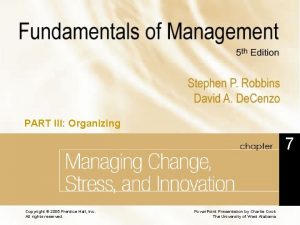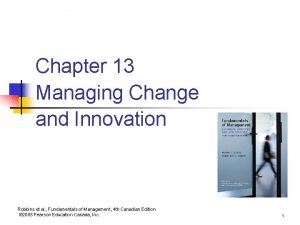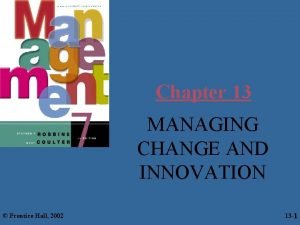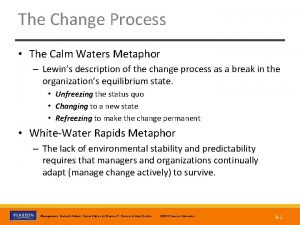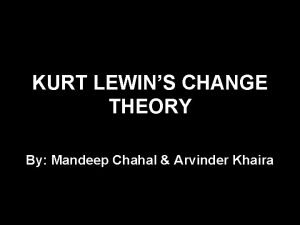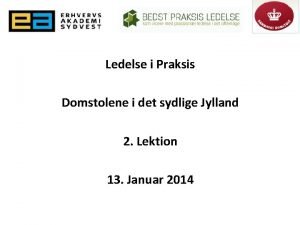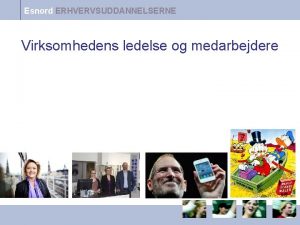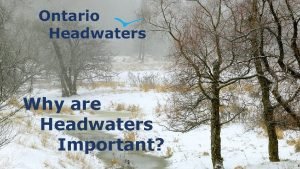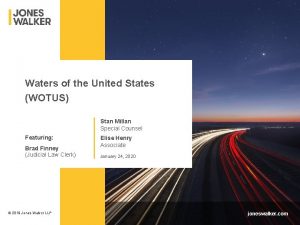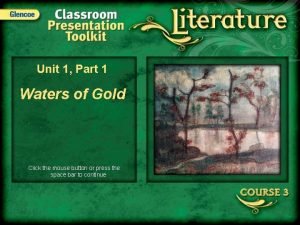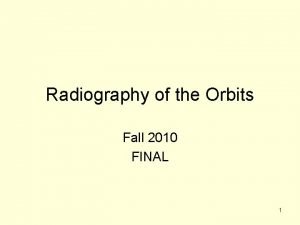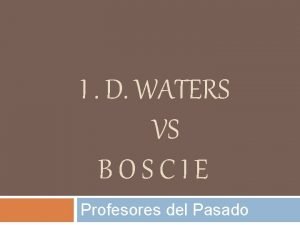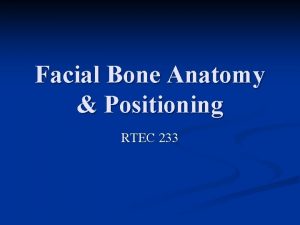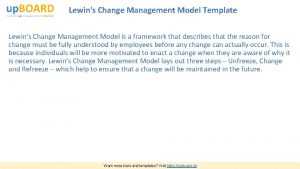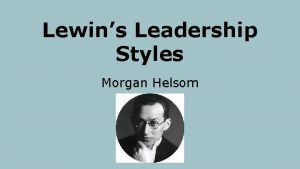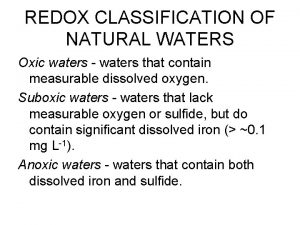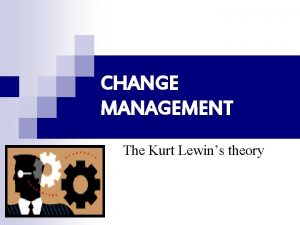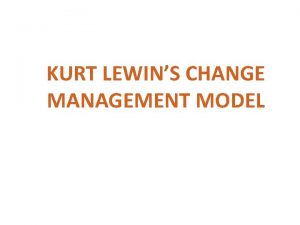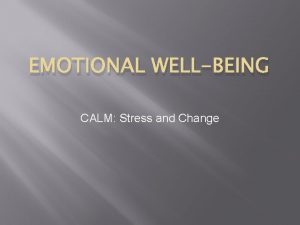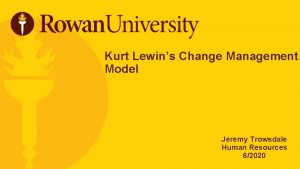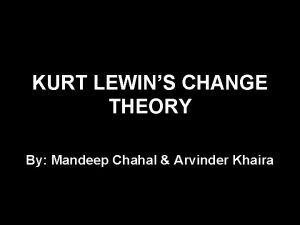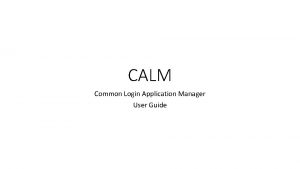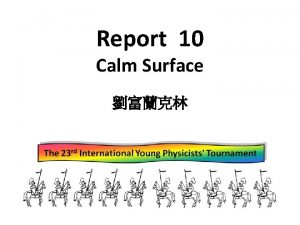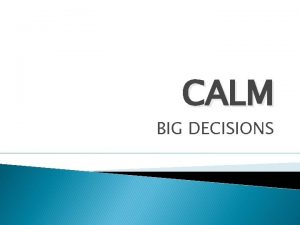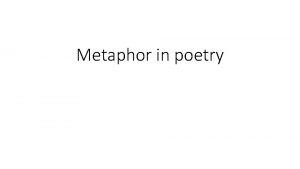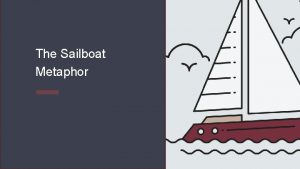The Change Process The Calm Waters Metaphor Lewins


















- Slides: 18

The Change Process • The Calm Waters Metaphor – Lewin’s description of the change process as a break in the organization’s equilibrium state. • Unfreezing the status quo • Changing to a new state • Refreezing to make the change permanent • White-Water Rapids Metaphor – The lack of environmental stability and predictability requires that managers and organizations continually adapt (manage change actively) to survive. Copyright © 2012 Pearson Education, Inc. © 2012 Pearson Education Publishing as Prentice Hall Management, Eleventh Edition, Global Edition by Stephen P. Robbins & Mary Coulter 6 -1

Exhibit 6 -1: External and Internal Forces for Change Copyright © 2012 Pearson Education, Inc. © 2012 Pearson Education Publishing as Prentice Hall Management, Eleventh Edition, Global Edition by Stephen P. Robbins & Mary Coulter 6 -2

Organizational Change and Change Agents • Organizational Change - any alterations in the people, structure, or technology of an organization. • Change Agents - persons who act as catalysts and assume the responsibility for managing the change process. Copyright © 2012 Pearson Education, Inc. © 2012 Pearson Education Publishing as Prentice Hall Management, Eleventh Edition, Global Edition by Stephen P. Robbins & Mary Coulter 6 -3

Types of Change Agents • Managers: internal entrepreneurs • Nonmanagers: change specialists • Outside consultants: change implementation experts Copyright © 2012 Pearson Education, Inc. © 2012 Pearson Education Publishing as Prentice Hall Management, Eleventh Edition, Global Edition by Stephen P. Robbins & Mary Coulter 6 -4

Exhibit 6 -2: The Three-Step Change Process Copyright © 2012 Pearson Education, Inc. © 2012 Pearson Education Publishing as Prentice Hall Management, Eleventh Edition, Global Edition by Stephen P. Robbins & Mary Coulter 6 -5

Types of Change • Structure – Changing an organization’s structural components or its structural design • Technology – Adopting new equipment, tools, or operating methods that displace old skills and require new ones • Automation - replacing certain tasks done by people with machines • Computerization • People – Changing attitudes, expectations, perceptions, and behaviors of the workforce Copyright © 2012 Pearson Education, Inc. © 2012 Pearson Education Publishing as Prentice Hall Management, Eleventh Edition, Global Edition by Stephen P. Robbins & Mary Coulter 6 -6

Organizational Development • Organizational Development (OD) techniques or programs to change people and the nature and quality of interpersonal work relationships. • Global OD - OD techniques that work for U. S. organizations may be inappropriate in other countries and cultures. Copyright © 2012 Pearson Education, Inc. © 2012 Pearson Education Publishing as Prentice Hall Management, Eleventh Edition, Global Edition by Stephen P. Robbins & Mary Coulter 6 -7

Managing Resistance to Change • Why People Resist Change – The ambiguity and uncertainty that change introduces – The comfort of old habits – A concern over personal loss of status, money, authority, friendships, and personal convenience – The perception that change is incompatible with the goals and interest of the organization Copyright © 2012 Pearson Education, Inc. © 2012 Pearson Education Publishing as Prentice Hall Management, Eleventh Edition, Global Edition by Stephen P. Robbins & Mary Coulter 6 -8

Changing Organizational Culture • Cultures are naturally resistant to change. • Conditions that facilitate cultural change: – The occurrence of a dramatic crisis – Leadership changing hands – A young, flexible, and small organization – A weak organizational culture Copyright © 2012 Pearson Education, Inc. © 2012 Pearson Education Publishing as Prentice Hall Management, Eleventh Edition, Global Edition by Stephen P. Robbins & Mary Coulter 6 -9

Stress and Stressors • Stress - the adverse reaction people have to excessive pressure placed on them from extraordinary demands, constraints, or opportunities. • Stressors - factors that cause stress. Copyright © 2012 Pearson Education, Inc. © 2012 Pearson Education Publishing as Prentice Hall Management, Eleventh Edition, Global Edition by Stephen P. Robbins & Mary Coulter 6 -10

What Causes Stress? • Role Conflicts - work expectations that are hard to satisfy. • Role Overload - having more work to accomplish than time permits. • Role Ambiguity - when role expectations are not clearly understood. Copyright © 2012 Pearson Education, Inc. © 2012 Pearson Education Publishing as Prentice Hall Management, Eleventh Edition, Global Edition by Stephen P. Robbins & Mary Coulter 6 -11

Personal Factors Causing Stress • Type A personality people who have a chronic sense of urgency and an excessive competitive drive. • Type B personality people who are relaxed and easygoing and accept change easily. Copyright © 2012 Pearson Education, Inc. © 2012 Pearson Education Publishing as Prentice Hall Management, Eleventh Edition, Global Edition by Stephen P. Robbins & Mary Coulter 6 -12

Stimulating Innovation • Creativity - the ability to combine ideas in a unique way or to make an unusual association. • Innovation - turning the outcomes of the creative process into useful products, services, or work methods. Copyright © 2012 Pearson Education, Inc. © 2012 Pearson Education Publishing as Prentice Hall Management, Eleventh Edition, Global Edition by Stephen P. Robbins & Mary Coulter 6 -13

Stimulating Innovation (cont. ) • Idea Champions individuals who actively and enthusiastically support new ideas, build support, overcome resistance, and ensure that innovations are implemented. Copyright © 2012 Pearson Education, Inc. © 2012 Pearson Education Publishing as Prentice Hall Management, Eleventh Edition, Global Edition by Stephen P. Robbins & Mary Coulter 6 -14

Structural Variables • Adopt an organic structure • Make available plentiful resources • Engage in frequent inter-unit communication • Minimize extreme time pressures on creative activities • Provide explicit support for creativity Copyright © 2012 Pearson Education, Inc. © 2012 Pearson Education Publishing as Prentice Hall Management, Eleventh Edition, Global Edition by Stephen P. Robbins & Mary Coulter 6 -15

Cultural Variables • Accept ambiguity • Tolerate the impractical • Have low external controls • Tolerate risk taking • Tolerate conflict • Focus on ends rather than means • Develop an open-system focus • Provide positive feedback Copyright © 2012 Pearson Education, Inc. © 2012 Pearson Education Publishing as Prentice Hall Management, Eleventh Edition, Global Edition by Stephen P. Robbins & Mary Coulter 6 -16

Human Resource Variables • Actively promote training and development to keep employees’ skills current • Offer high job security to encourage risk taking • Encourage individuals to be “champions” of change Copyright © 2012 Pearson Education, Inc. © 2012 Pearson Education Publishing as Prentice Hall Management, Eleventh Edition, Global Edition by Stephen P. Robbins & Mary Coulter 6 -17

Terms to Know • • organizational change agent organizational development (OD) stress creativity innovation idea champion Copyright © 2012 Pearson Education, Inc. © 2012 Pearson Education Publishing as Prentice Hall Management, Eleventh Edition, Global Edition by Stephen P. Robbins & Mary Coulter 6 -18
 The calm waters metaphor
The calm waters metaphor White-water rapids metaphor
White-water rapids metaphor The calm waters metaphor
The calm waters metaphor The calm waters metaphor
The calm waters metaphor Kurt lewins change theory
Kurt lewins change theory Lewins 3 ledelsesformer
Lewins 3 ledelsesformer Scheins teori
Scheins teori What are headwaters
What are headwaters Waters of millan
Waters of millan Submentovertical projection
Submentovertical projection Waters of gold summary
Waters of gold summary Hazel grace lancaster
Hazel grace lancaster Rheese orbits positioning
Rheese orbits positioning Irregular preterite and imperfect verbs
Irregular preterite and imperfect verbs London 1802 imagery
London 1802 imagery The devilfish in egyptian waters
The devilfish in egyptian waters Waters en pasado participio
Waters en pasado participio Waters positioning
Waters positioning Caldwell-luc operation
Caldwell-luc operation
